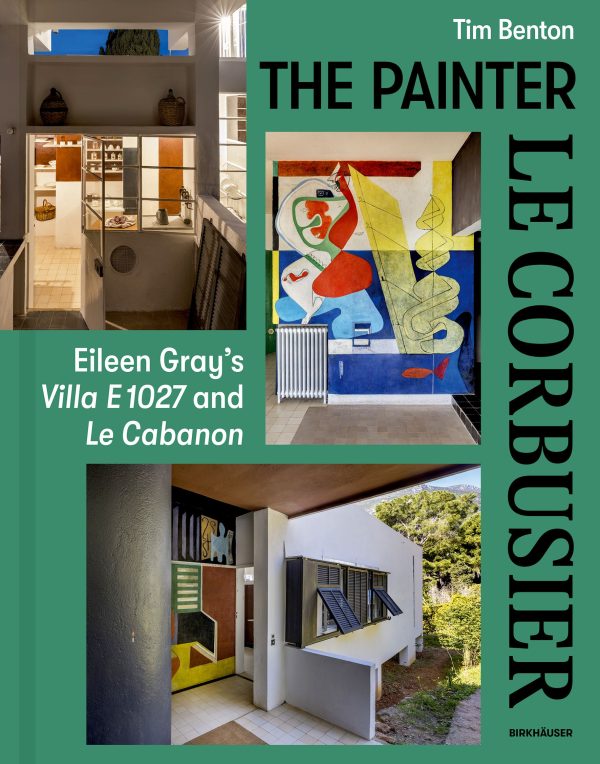
“From the end of the 1930s onwards, Le Corbusier tested the possibilities of mural painting to enliven architectural space. Following a first project in Vézelay in 1936, the walls of the Villa E1027 designed by Eileen Gray provided him with the opportunity to experiment with an artistic practice that was still new to him. The Cap-Martin site would later host many other murals by the architect – it is this collection that is presented by this publication.”
- Antoine Picon from the Foreword
AUTHOR: Tim Benton, with photography by Manuel Bougot (Birkhäuser Verlag 2023)
For several generations now, the figure of Le Corbusier has loomed large in our discussions around the built environment, with 17 of his buildings being recognized as UNESCO world heritage sites in 2016. But while our discussions often involve his buildings or five points, we often forget that he was as well an accomplished painter, whose work had been exhibited alongside other Cubist and Purist painters of his day. While his paintings have remained more a part of his personal life, a recent restoration of the Roquebrune-Cap-Martin site where he frequently vacationed has provided an opportunity to look at the time he spent there painting over three decades.
As the book celebrates and analyzes the architect’s paintings throughout his entire life, this publication puts particular emphasis on eight murals he did on the walls of Eileen Gray’s E-1027 villa. The elephant in the room is that the murals were never commissioned by Gray, and are seen by several prominent architecture critics as an intrusion and violation by Le Corbusier of such a seminal work. The book’s authors state as much in the opening pages, leaving it to the reader to decide which is the chicken and which is the egg. Regardless, the murals in the book were recognized in 1975 for their historical significance since which time they have been listed for protection.
As it turns out, E-1027 started out as a love story, one between an Irish architect and Romanian magazine editor—Eileen Gray and Jean Badovici, respectively—who designed and built the villa for themselves in 1929. Its name is derived from their initials, with E for Eileen, but sadly they only lived in it for three years before they parted ways. Badovici, who was editor of L’Architecture Vivante at the time, had the deed to E-1027 in his name and having known Le Corbusier for many years, invited him and his wife Yvonne there several times starting in 1937.
Le Corbusier and Yvonne at the time had also been vacationing at San Tropez, and it was there where Le Corbusier was struck by a speeding motorboat while swimming offshore. The injuries he sustained are described within the book in horrific detail—how his brow was split open, with the propeller shredding his right leg. The time he spent recovering included the period when he painted the murals at E-1027, during which time both his artistic and architectural sensibilities were undergoing a dramatic transformation. As much a product of the swimming accident, Benton and others also note the falling out with his cousin and others who veered into far Left politics—also contributing to his dramatic break from much which he had advocated in the 1920s.
Along with Benton’s contributions here as an art historian he must also be commended as editor—the book is as much a lesson in modern art as it is about Corb’s paintings. He also acknowledges the Rebutato family, who had long lived and worked on the site and recognized its importance, forming the Association Eileen Gray-Etoile de Mer-Le Corbusier in 2000. With the passing of one of its founders in 2016, the foundation has carried on with its remaining founder, Magda, who orchestrated the book’s release in three languages—English, French, and German—corresponding with a much-needed recent restoration of the site. That it is any shape at all for the public to visit is nothing short of a miracle given the state it was in after the Second World War (German soldiers used it for target practice).
Given its location on the French Riviera across the bay from Monaco, there is no question what the attraction has been to the site over the years. Le Corbusier had never had the chance to realize a structure in such an idyllic seaside location. In the book’s opening salvo, a half dozen pairings of full-colour pages set the stage, capturing the site and E-1027 along the sunlit Mediterranean coast, with an interior shot of the house to show some of Gray’s furnishings, including her iconic adjustable table. Directly adjacent to the villa are a few other structures, including a restaurant, some changing rooms, and the small cabin that Le Corbusier built in 1951 and decorated with his paintings—Le Cabanon—also one of the 17 UNESCO world heritage structures.
The book is broken into three sections, first delving into Le Corbusier the artist, and how his painting transitioned to murals, followed by a chapter devoted to the Villa E-1027 and its complex history—including the politics around Le Corbusier’s added murals. The final section of the book is devoted to the murals he painted in the other structures at Cap Martin, along with two others he did on Long Island. By 1945, Benton believes Le Corbusier had arrived at a ‘synthesis of the arts,’ at long last reconciling the use of colour in his architecture through the use of mural painting:
To try to explain his ideas on the synthesis of the arts, Le Corbusier came up with the idea of ‘ineffable space’. His idea was that when all the elements of a space – volumes, colour, sculpture – are perfectly in harmony, a magical transformation takes place which corresponds to the aesthetic moment, when, to use the language of his book Modulor, the physical becomes spiritual (or ‘divine’). Whatever one might think of Le Corbusier’s abuse of the ‘laboratory’ of E-1027 in 1938-1939, it formed part of a very rich development in his artistic creativity.
Part art history lesson on mural painting, from the Renaissance to Guernica, and part architecture lesson on the Functionalist oeuvre to which both Eileen Gray and Le Corbusier contributed, Benton should be commended for publishing as much of Le Corbusier’s paintings as he’s been able to provide in one place—many in glorious full colour. The controversy about the murals will certainly continue, just as the history of E-1027 itself following Badovici’s passing in 1956 has had a torturous journey, including a botched attempt by the government at restoring the house to its original state, along with a fatal shooting there in 1996.
Le Corbusier himself passed away floating in the bay a few hundred feet from E-1027 and his Cabanon in 1965, perhaps entirely transformed from the functionalist and industrial design sensibilities of his youth, approaching something more humanistic and spiritual that may have informed his work in his final years. The Association overseeing the Cap Martin site certainly feels this way along with the book’s contributors, ensuring that equal parts recognition is given to both Eileen Gray and Le Corbusier, whether for the contributions they brought to the site or the inspirations that it provided for each of them.
***
For more information on The Painter Le Corbusier, go to the Birkhäuser Verlag website.
**
Sean Ruthen is a Metro Vancouver-based architect and writer.


